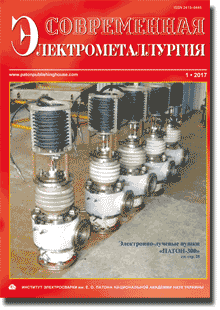| 2017 №01 (03) |
DOI of Article 10.15407/sem2017.01.04 |
2017 №01 (05) |

Electrometallurgy Today (Sovremennaya Elektrometallurgiya), 2017, #1, 22-28 pages
Electron beam technology of producing condensates Ag–NaCl and physical-chemical properties of colloid system on their base
Didikin G.G.1, Andrusishina I.N.2, Litvin S.E.1, Krushinskaya L.A.1, Grabin V.V.1
1E.O. Paton Electric Welding Institute, NASU. 11 Kazimir Malevich Str., 03680, Kiev, Ukraine. E-mail: office@paton.kiev.ua
2Institute of Occupational Medicine, NAMSU
On the base of porous condensates of NaCl–Ag composition, synthesized by the electron beam evaporation and condensation in vacuum, the stable water colloid systems with silver nanoparticles were produced. Stabilization of nanoparticles in water colloids was made by using the human serum albumine. With adding of silver in the form of refined condensate NaCl–Ag in the amount of 100 mg/l into water (0.1…1.0 %) solution of albumine the fraction of nanoparticles of silver, transferred into colloid in the obtained heterogeneous system is determined by the concentration of albumine in the solution and solution acidity (pH). Stable value of average size of particles (6…10 nm) in time and their maximum fraction are attained in water colloid solution, containing 110 mg/l of albumine at its acidity in the range of pH = 7.1…7.7. With increase in pH of medium the fraction of silver nanoparticles in colloid was decreased to 2 mg/l and remained unchanged up to pH = 10. Ref. 23, Figures 7.
Keywords: EB PVD; condensates; nanoparticles; silver; albumine; colloid; acidity
References
1. Sergeyev G. B. (2001) Nanokhimiya metallov. Uspekhi khimii, T. 70, 10, 915-933.2. Ulberh Z., Hruzina T., Karpov O. (2008) Nanotekhnolohii v medytsyni: rol koloidno-khimichnykh protsesiv. Visnyk NAN Ukrainy, 8, 28-41.
3. Gubin S. P., Yurkov G. Yu., Katayeva N. A. Nanochastitsy blagorodnykh metallov i materialy na ikh osnove.- Moskva: IONKh RAN, 2006.- 155 s.
4. I. S. Chekman i dr. (2008) Nanoserebro: tekhnologii polucheniya, farmakologicheskiye svoystva, pokazaniya k primeneniyu. Preparaty i tekhnolohii, 3, 32-34.
5. Yershov B. G. (2001) Nanochastitsy metallov v vodnykh rastvorakh: elektronnye, opticheskiye i kataliticheskiye svoystva. Rossysky khimichesky zhurnal, T. 14, 3, 20-30.
6. P. Christian et al. (2008) Nanoparticles: structure, properties, preparation and behavior in environmental media. Ecotoxicology, V. 17, 26-343. https://doi.org/10.1007/s10646-008-0213-1
7. M. Hasselov et al. (2008) Nanoparticles and characterization methodologies in environmental risk assessment of engineering nanoparticles. Ibid, 14, 344-361.
8. Chen J. Ch., Wiley B. J., Xia Yu. (2007) One-dimensional nanostructures of metals: large-scale synthesis and some potential applications. Langmir, 23, 4120-4129. https://doi.org/10.1021/la063193y
9. K. G. Lopatko i dr. (2010) Polucheniye i primeneniye nanochastits, soderzhashchikh med i serebro. Tr. Instituta problem materialovedeniya, 1, 232-243.
10. L. Manhong et al. (2000) An investigation of the interaction between polyvinilpyrrolidone and metal cations. React. Funct. Polym, V. 44, 1, 55-64. https://doi.org/10.1016/S1381-5148(99)00077-2
11. Zong-ming Xiu et al. (2012) Negligible particle-specific antibacterial activity of silver. Nano Lett, V. 40, 30, 301-305. https://doi.org/10.1021/nl301934w
12. Pat. 75670 Ukraina, MPK B82B 3/00, C23C 14/24, V01J 13\00. Sposib oderzhannia koloidnoho rozchynu sribla / B. O. Movchan ta in.- Opubl. 10.12.12. Biul. 23.
13. Sposib oderzhannia nanochastynok systemy metal-kysen iz zadanym skladom elektronno-promenevym vyparovuvanniam i kondensatsiieiu u vakuumi () Patent Ukrainy na vynakhid 92556, biuleten 21 vid 10.11.2010. . , , .
14. Lazernaya korrelyatsionnaya spektroskopiya v biologii / A. D. Lebedev i dr.- Kiev: Naukova dumka, 1987.- 256 s.
15. Henk G. Merkus. Particle Size Measurements. Fundamentals, Practice, Quality.- Springer, 2009.- 533 p.
16. Metodicheskiye ukazaniya 4.1.1482-03 «Opredeleniye khimicheskikh elementov v biologicheskikh sredakh i preparatakh metodami atomno-emissionnoy spektrometrii s induktivno-svyazannoy plazmoy i masspektrometrii s induktivnosvyazannoy plazmoy».- Moskva: Minzdrav Rossii, 2003.- 16 s.
17. Tomson M., Uolsh D. N. Rukovodstvo po spektrometricheskomu analizu s induktivno-svyazannoy plazmoy.- Moskva: Nedra, 1988.- 287 s.
18. Movchan B. A. (2008) Elektronno-luchevaya gibridnaya nanotekhnologiya osazhdeniya neorganicheskikh materialov v vakuume. Aktualnye problemy sovremennogo materialovedeniya. Kyiv: Vydavnychyi Dim «Akademperiodyka», 227-247.
19. A. I. Stepuro i dr. (2007) Stabilizatsiya chastichno-okislennykh nanochastits serebra syvorotochnym albuminom cheloveka. Mater. mezhd. konf. «Lekarstvennye sredstva i biologicheski aktivnye soyedineniya», Grodno, , 159-161.
20. Y. Stetychyn et al. (2010) The formation and properties of dextran-albumine nanostructure on the glass surface. Ukrainian-German Symposium on physics and chemistry of nanostructures and on nanobiotechnology: Book abstract. Crimea, 31.
21. J. Diendorf et al. () Silver nanoparticles: synthesis, dissolution and toxicity. Ibid, , 20.
22. L. Manhong et al. (2000) An investigation of the interaction between polyvinilpyrrolidone and metal cations. Reactive amd functional polymers, V. 44 (1), 55-56.
23. Minchenko D., Bozhko I., Zinchenko T. Expression of SNF1/ AMPactivated protein kinase in the brain, liver, lungs, kidney and heart is a sensitive marker of silver nanoparticles action / Materials of Ukrainian-German Symposium on Physics and Chemistry of nanostructures and on nanobiotechnology (Beregove, 6-10 sept, 2010).- Crimea, Ukraine, 2010.- P. 204.
